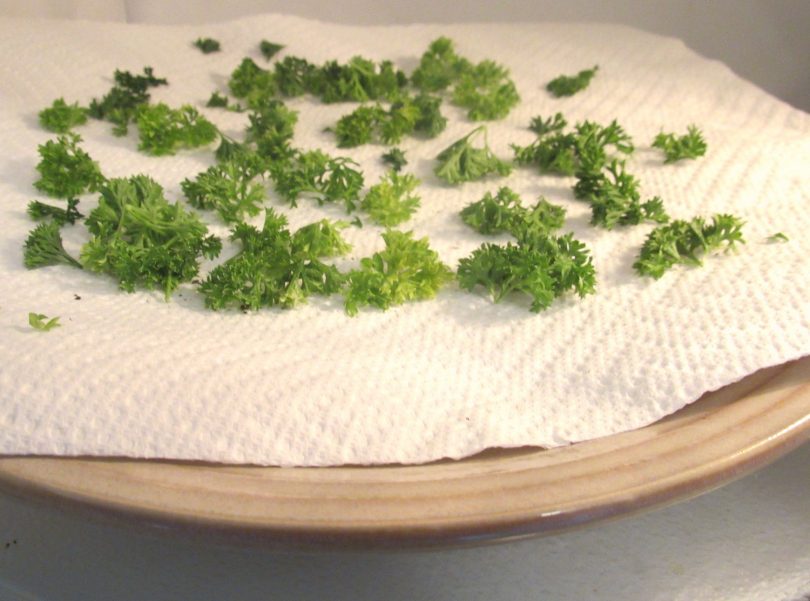Drying herbs overall and in a microwave especially is an easy process as long as you know what to keep in mind.
Drying your own herbs works especially well when you have your own spice garden. After all, what better assurance of quality is there than from the greens you grew and picked yourself?
There are three ways to dry your own herbs:
- The first and most common of them is air drying, which involves tying the herbs and letting them dry naturally.
- The second is through a conventional oven, where the herbs are gradually dried from exposure to heat.
- The third is drying herbs in a microwave, which uses much of the same techniques as oven drying.
Drying Herbs in a Microwave – Things You Need to Know
Patience and precision
Traditionally, fresh herbs are air-dried over the course of several days by hanging them upside down inside the kitchen. Air drying still provides some of the best results for the least amount of effort.
But, it does have the disadvantage of taking over several days to run its course. Moreover, air-dried herbs require good ventilation and the absence of humidity. Humid air can delay the drying process and cause the herbs to rot. In some climates, it may be impossible to air dry herbs at all.
If you’re willing to risk it, you can also dry your herbs in the oven, which can reduce the amount you need to wait over a course of several hours while eliminating the risk of rot. If you live in a place where the humidity is usually high, then ovens are often the only way to effectively dry your own herbs.
However, to maximize the quality of the herbs, you would need to be very careful with the heat over the course of the process due to the risk of burning. This can be a daunting, challenging process.
A time-saving alternative – drying herbs in a microwave
Microwaves work by exciting the water molecules within the food, which would rapidly produce a lot of heat in a short amount of time. The microwave oven can effectively dry out herbs in a span of a few minutes; in contrast, a conventional oven dries out herbs over the course of an hour or more.
Despite being the quickest method, drying herbs in a microwave isn’t as simple as sticking herbs in a microwave and letting it run. Much like when drying herbs in a conventional oven, you would need to prepare the herbs carefully and watch them closely to ensure that they dry thoroughly and to avoid burning them.
All types of herbs can be dried through a microwave. This method delivers the best results, however, with delicate types of herbs like chives and cilantro.
Preparation
When drying fresh herbs in a microwave, it is especially important for you not to remove too much of the natural essential oils that accumulate in the surface. Avoid over-washing the herbs. When you picked them fresh from your own garden, you do not need to give them anything more than a slight rinse if they’re dirty.
When picking home-grown herbs, choose the appropriate time to harvest. The ideal time to harvest herbs is mid-morning when the dew has already dried but the essential oils have yet to evaporate.
Upon rinsing, immediately dry the herbs as well as you can with a salad spinner, then pat them dry with a dishtowel. Removing as much excess moisture as possible is crucial when drying herbs in both a microwave and a conventional oven. This not only makes it easier for the herbs to thoroughly dry out but also prevents them from cooking.
A matter of care
Before microwaving, separate the leaves from the stems. Distribute these evenly on a paper towel over a microwave-safe dish, then put another paper towel on top.
You would get the best results from small batches of herbs. Place no more than four or five herb branches in the microwave at any given time to ensure ample space between them. It is vitally important that the herbs do not touch one another throughout this process.
Microwave on high for approximately one minute, then repeat the process every 20 to 30 seconds until the herbs have thoroughly dried. Flip the herbs between each interval to ensure that they dry thoroughly.
Depending on the moisture content of the herbs, this process can take up to ten minutes. Pay close attention to the herbs as they microwave and don’t let them sit for too long. Stop the process when you smell the herbs burning.
Here is a great video about microwaving herbs.
After you’ve microwaved your herbs, place them in a rack and let them cool down. The resulting herbs should be firm and crisp and would crumble easily on hand.
Storing the herbs
Once they’ve cooled, the now-dry herbs are ready for use and can be added to any dish. Dried herbs have a more concentrated flavor profile compared with fresh herbs, however, and your recipes will likely require far fewer dried herbs as a result.
Thus, you may find that you’ve prepared more herbs than you’d need at any one time. Preparing dried herbs for storage is easy and allows you to save time by drying them in batches for future use. Herbs are ideally stored in small, airtight containers and kept in a cool, dry space.
You can crumble the dried herbs to make them easy to store and convenient to use when cooking. Use clean fingers or a mortar and pestle to crumble the herbs. Be sure to remove any hard stems you might find. Alternatively, you may preserve more of the herb’s essential oils by storing them intact. In general, whole herbs keep for far longer than crumbled ones.
Stored properly, a batch of dried herbs can keep for 6 to 12 months. Of course, dried herbs are best used as soon as possible to take advantage of their full flavor. To keep track of their freshness, be sure to label the date that they were purchased or harvested.
READ ALSO: A Complete Guide on How to Store Dried Herbs
No Reason Not To
Drying herbs at home helps ensure the quality of herbs you use in the kitchen. Too often, store-bought dry herbs lack the strength of flavor. And so, many professional chefs and dedicated cooking enthusiasts alike insist on drying their own herbs for cooking.
Now that you know how easy it is to start drying herbs in a microwave, there’s no reason why you shouldn’t give it a try. Soon, you might even choose to prepare an assortment of herbs to add both convenience and excitement to your future culinary pursuits.





